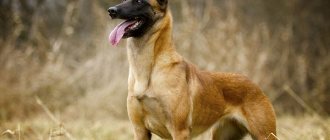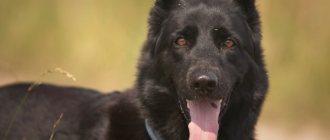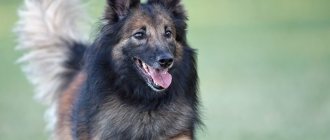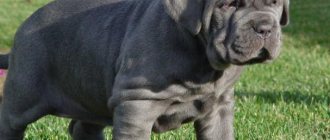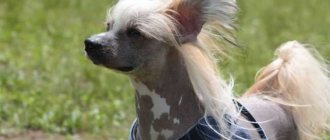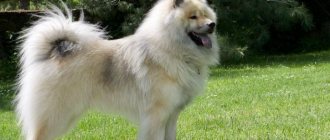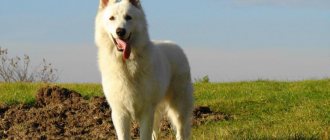Malinois, Groenendael, Tervuren and Laekenois are varieties of the Belgian Shepherd. Many people mistakenly believe that all these dogs are separate breeds. Actually this is not true. The fact is that the FCI has approved a single breed standard, called the “Belgian Shepherd,” which unites four varieties. Animals are very similar to each other, but they also have certain differences. First of all, this manifests itself in the quality of the coat and the performance of dogs.
Today, the Malinois (Belgian Shepherd) is the most popular of the four varieties. Its name translates as “shepherd dog from Malin”. The Belgians call the small Flemish town of Mechelen that way. It was in its vicinity that this breed type was finally formed.
From the history of the breed
The Malinois breed owes its appearance to Professor of Animal Science Adolf Reul. In September 1891, the Belgian Shepherd Club began its activities. In the very first standard, the breed was divided into four groups:
- black longhair (groenendael);
- long-haired red (Tervuren);
- shorthair with black mask (Malinois);
- red or ash-colored rough-haired (Laekenois).
The first short-haired Belgian Shepherd was Charlie in 1891. Later, this dog became the “model” of the Belgian Malinois for the artist A. Claris.
History of the Belgian Malinois
The Belgian Malinois is a native of Belgium and one of four varieties of Belgian Shepherds. The other three varieties are Tervuren, Groenendael and Laekenois.
These Belgian Shepherds were developed in Belgium in the late 1800s and are registered in Belgium and France as the Chien de Berger Beige. The Malinois was named after the city of Malins, where it was bred.
Belgian Malinois first arrived in the United States around 1911 and gained popularity. Some were used as military working dogs during the First World War.
The breed became less common during the Great Depression, but enthusiasm for the breed returned in the late 1950s and early 1960s, and it was recognized by the American Kennel Club in 1959. By the early 21st century, Belgian Malinois were commonly employed as police dogs, military working dogs, drug detection dogs, and rescue dogs. Belgian Malinois are hired by the Secret Service to patrol the White House grounds.
Belgian Malinois are part of Navy SEAL teams and have been used in operations, including the one that killed Osama bin Laden in 2011. These dogs wear body armor and can use night vision goggles. They can participate in parachuting for military operations.
Dimensions and proportions
The Belgian Malinois, a photo of which you can see in our article, is a rather large dog. Height at the withers for males is 62-66 cm, for females - 56-62 cm. If the animal does not fit into these parameters, this is considered a fault. In accordance with the standard, the height of a male dog should be equal to the length of his back; females are allowed a longer body. Bones of medium weight, proportional to the height of the animal. The Malinois Shepherd should have a square-like outline. Her body should not be too elongated and long-legged or large and heavy.
The head is well defined, not too heavy, and in proportion to the body. The eyes are almond-shaped, medium in size, edged in black. They are usually dark brown.
The muzzle is slightly tapering towards the nose, but not sharp. Powerful and strong jaws. The lips are dense, black and pink.
The teeth are straight and white. The bite should be scissor-shaped and straight. An undershot or overshot bite is considered a defect. An even bigger disadvantage is the absence of one or more teeth. If there is an overbite, when two or more upper incisors do not touch the lower ones, the dog may be disqualified.
Description of the Malinois breed
Belgian Shepherds are a herding breed. One of the 4 types of national working dogs is the Malinois. This breed was developed only at the end of the 19th century, but based on the herding dogs common in Belgium. Particular attention was paid to her working qualities. Therefore, the Malinois is an excellent helper on the farm, a shepherd, a watchman, and a companion. For this dog, it is simply necessary to serve a person; without work and attention, it becomes aggressive and hot-tempered.
The Malinois is suitable for an experienced dog breeder who can pay enough attention to it and raise it properly. Then she will become a devoted friend, an obedient assistant and a faithful protector to him and his family members.
In appearance, the Malinois is a lean, muscular, harmoniously built dog with a proud posture. Its features are a narrow elongated muzzle with a black mask, triangular erect ears, short and thick yellow-brown fur. Moves easily and can change direction at high speed. Likes to run fast in circles and jump.
| Options | Characteristic |
| breed name | Belgian Shepherd |
| country of origin | Belgium |
| year of breed registration | 1891 |
| group of breeds according to the ICF classification | herding and cattle dogs, shepherd section |
| purpose of the breed | shepherd, service, companion |
| life expectancy | 12-14 years old |
| height | males 60-66 cm, females 56-62 cm |
| weight | males 25-30 kg, females 20-25 kg |
| character traits | smart, independent, hardworking, self-reliant, loyal, responsible, observant |
| attitude towards a person | loyal, affectionate, do not tolerate loneliness well |
| activity | requires a lot of physical activity, constant employment |
| training | lends itself well, but requires gaining authority |
| difficulty of care | unpretentious, easy to care for, but sheds all year round |
| health | good |
pros
The Malinois is the most sought after service dog in the world. She is hardy, efficient, and has excellent watchdog qualities. Often used for service in the police, army, security, rescue services, helps search for drugs and chemicals. She is considered the smartest dog, capable of making independent decisions in extreme situations. With proper upbringing, the dog will become a devoted friend, companion and protector. Representatives of the breed have many advantages:
- unpretentious, suitable for keeping in an apartment, country house, or on a plot;
- treat children well;
- very smart, quick-witted, have good memory and instant reaction, learn quickly;
- love fun games, intellectual activities;
- calm, balanced character;
- devoted, faithful, love the owner and his family members;
- have excellent watchdog qualities, vigilantly guard the owner and property, and bravely rush to defense;
- have good health, hardly get sick, remain active until old age;
- a good companion for travel, outdoor activities, sports;
- can be taught various complex tricks;
- one of the best breeds for service in the police, the Ministry of Emergency Situations.
Minuses
This Belgian Shepherd is not for everyone. It should not be owned by inexperienced owners, those who lead a sedentary lifestyle or cannot show strength of character. This pet needs to be given a lot of attention and time; without human communication and intellectual pursuits, it can become aggressive and uncontrollable. This is not a lap pet or a chain watch dog, but a dog for serious daily work.
The Malinois has several other disadvantages:
- requires constant attention from the owner and training;
- cannot stand loneliness, they can ruin an apartment out of boredom;
- suitable only for an experienced owner with leadership qualities;
- high physical activity required;
- may show aggression towards other animals if they did not grow up with them;
- suspicious of strangers;
- They are very active, jump high, so they can get injured.
An interesting video will tell you about the pros and cons of the breed:
Video: Malinois Shepherd Dog. Pros and cons of this breed.
Video: 5 Advantages of the Malinois breed!
Application of Malinois
Of all the Belgian Shepherds, the Malinois is the most common. These dogs have no equal in various sports - agility, modjoring, freestyle. They are superior to other breeds in speed, jumping, reaction speed, and the ability to make independent decisions.
Therefore, Malinois serve in the police, customs, and border troops. They are the best bloodhounds and rescuers, and can work as guide dogs. These dogs serve in hot spots and areas of natural disasters. They quickly look for explosives, drugs, people under the rubble.
It is not advisable to use Malinois as watchdogs. These dogs cannot be kept on a chain, they are very smart and should become a friend and helper to a person. They definitely need activities in which they demonstrate their ability to analyze, think, and make decisions. They love to search, recognize smells, and perform complex tricks.
Color
According to the Malinois standard, the coat can be colored in a variety of colors, ranging from mahogany to light yellow. The mask, ears, and hair tips should be black. Fawn but blurred color is a defect.
The tips of the paws may be white, and white spots on the chest are also allowed if they do not extend to the neck. Other white spots are disqualifying.
Breed standard
The Malinois is a medium-sized dog. This is a muscular, flexible animal. Females have a more elongated physique, males have a more square format. The weight of adults is 25-30 kg. , height about 61-66 cm .
The neck has a beautiful curve, but at the same time it is powerful; there should be no folds on the neck. A slightly elongated head rests on it. The ears are open, triangular in shape, and carried high. The eyes are brown and almond-shaped. The look is lively, intelligent, attentive. The bridge of the nose is straight, the nose is large and black. Scissor bite.
The physique is strong, the back is straight and wide. The shoulder girdle is powerful, the chest is deep, not too wide. The tail is wide, with a curved tip. The Malinois does not raise it above the line of the back. The limbs are smooth, muscular, the hips are wide. The movements are sweeping, creating the appearance of springiness in the paws.
The main difference between the Malinois and other types of Belgian Shepherd is its coat. The hair of representatives of this breed is short. The hair is tight, not too hard. There is a collar on the neck, and a not very lush bouffant on the tail. The undercoat is dense and well developed. This coat reliably protects the shepherd from natural precipitation.
The coat color is red with charcoal, yellow-brown or red-brown tint. The color should not be too saturated or too light, it is called warm, deer. The ears are dark, and there is a black mask on the muzzle.
Character
The Malinois (Belgian Shepherd) has absorbed the best qualities of a guard, shepherd and protector. This is a very smart dog, which, oddly enough, is both a plus and a minus of the breed. In skillful and kind hands, she quickly and easily becomes an ideal working dog. An uneducated and untrained Malinois just as quickly turns into an “evil genius,” uncontrollable and wayward. It is probably for this reason that experts believe that such a dog is not suitable for every owner. A very athletic and active animal needs work. A dog does not have enough physical exercise (long walks, running behind a bicycle); it needs intellectual exercise - agility, obedience classes, herding or protective service.
When a Malinois Shepherd is bored, it can be somewhat clingy. She may start to get mischievous, but much more often the dog is emphatically serious. She is not at all aggressive, but always very carefully monitors the actions and movements of strangers.
The Belgian Malinois (the characteristics of experts convince us of this) has a well-developed guard instinct, so it needs early socialization. This will help channel her innate vigilance in the right direction.
History of the breed
The Malinois is one of the four types of Belgian Shepherd. The dogs are native to Belgium; they were bred in the Flemish region, in the vicinity of Mechelen. Uninformed people might think because of the name of the breed that Malinois comes from France, but this is not the case. The Malinois is rightfully considered the national breed of Belgium.
The first shepherd dogs arose in Belgium through the efforts of nature and shepherds. Belgians were considered ideal assistants in herding livestock. But over time, the use of these dogs has expanded significantly.
At first, appreciating the merits of the Malinois, several enthusiasts began to improve them. At that time, through the efforts of breed connoisseurs, a small breeding club was created. In the selection work, the best producers were used, who did not have documents, but had an excellent exterior.
As a result, representatives of the breed deservedly gained popularity as service dogs, shepherd dogs, police dogs, guide dogs and sniffer dogs. In terms of their working qualities, they even surpassed German shepherds.
In 1898, the first club of breed connoisseurs was created on an official basis. Interestingly, the name Malinois was adopted 20 years after the start of breeding work. Belgian Shepherds are famous for their efficiency, obedience and devotion.
Learning and training
The Belgian Shepherd is completely oriented towards its owner. She responds with joy, and even delight, to all his proposals. If from the very first acquaintance a close psychological contact has been established between an animal and a person, then training a pet will not cause any difficulties. But a novice owner may encounter some difficulties. To prevent this from happening, you need to know that the Malinois is extremely sensitive to physical stress, so training should be carried out by a person with a strong will, but without rudeness.
The Malinois has an instant reaction, the dog grasps everything on the fly. Therefore, the owner needs to accurately capture the moment of encouragement or reproach. Otherwise, you may develop undesirable behavior.
It should be noted that the Malinois very accurately reads all the body movements of the owner and his facial expression. Sometimes this confuses the inexperienced owner - it feels like the dog is always one step ahead. Belgian Shepherds require consistent training - they love to complete a given task and move on to the next.
Maintenance and care
A Belgian Shepherd in the house will require compliance with certain hygiene rules. You should not bathe such a dog often, as even very high-quality dog shampoos can ruin your pet’s coat. It may lose its natural dullness and rigidity. It should not be soft and shiny.
To get rid of the characteristic dog “smell,” you can use commercially available products, but they should be used in very measured doses. Puppies under one year of age should not be bathed at all.
The coat should be brushed with a dry brush about once a week (adult dog) and twice a week if it is a puppy. The comb for combing should have wide teeth.
The eyes, nose and ears are cleaned with a cotton swab dipped in warm water.
Malinois - puppies
Before deciding to purchase a pet, you need to carefully weigh the pros and cons. This is necessary in order to guarantee the full development of the animal and its proper upbringing. You must clearly define for yourself for what purposes you need this particular dog. Before purchasing a puppy, try to get the most detailed advice from a specialist about the breed.
Puppies can be taken from their mother at 10-16 weeks of age. By this age, the baby is already quite independent and is even able to learn the first lessons of education.
It is necessary to buy a dog from a specialized nursery or from a well-established breeder. This gives you certain guarantees that you are purchasing a purebred, and most importantly, a healthy animal. You need to familiarize yourself with all the “dog documents”: pedigree, puppy card, find out how the vaccination was carried out. It would be a good idea to get to know his parents, or at least one of them, so that you have an idea of how your Malinois will grow up. The Belgian Shepherd can make an excellent watchdog. Thanks to his intelligence, he can become a careful and attentive guide for visually impaired people. He can become a hero and winner of dog shows and just a reliable and devoted friend. Once you have purchased a puppy, its fate is in your hands.
Raising a puppy will require significant effort from the owner. In the first months, try not to disturb the baby during his rest, do not tire him with too long walks and games. First of all, your baby must learn to walk on a leash and learn his name.
By the way, you should name the puppy briefly and clearly. Over time, he will begin to associate his “name” with attention and affection.
In the hands of an attentive and experienced owner, the Malinois easily performs the most difficult tasks, while rude attitude has a detrimental effect on the dog’s psyche. This attitude can turn a puppy, ready to do anything for its owner, into an unhappy coward and neurasthenic.
Nutrition
You shouldn't feed your Malinois simplistically. This active dog needs a variety of foods daily to replenish its energy levels. By the way, meat, which dogs love so much and digest well, should be combined with other products.
For the normal development of an active dog, proteins are needed, both animal and plant origin. To do this, the diet should include foods such as fish, dairy products (but not milk), eggs, and meat. Malinois should also receive carbohydrates, which are contained in cereals such as rice, wheat, buckwheat, and pearl barley.
Don't forget to include vegetable oil and butter in your pet's diet. Animal and vegetable fats promote energy storage.
When feeding your dog natural food, you should add minerals and vitamins, without which the normal functioning of the dog’s body is impossible. They are found in both fresh and lightly cooked vegetables and fruits.
Some Malinois owners feed their pets ready-made dry food. But one cannot ignore the fact that such foods are often poorly digestible and can cause intestinal problems. Therefore, it is best to consult your veterinarian first. He will help you choose the right food that is best for your dog, taking into account his age, weight and overall health.
Don't forget that your pet should always have unlimited access to drinking water.
Health
The Malinois is considered a naturally healthy dog. The average life expectancy is 12-14 years. There is a predisposition to certain diseases among representatives of the breed, but many problems can be avoided with proper care, feeding, and timely vaccination. It is also important to conduct regular preventive examinations at a veterinary clinic and treatment for parasites.
No matter how well you take care of your pet, some diseases cannot be prevented. The owner should know what health problems are most common in Malinois:
- Cataracts are an eye disease that can lead to vision loss.
- Joint dysplasia is characterized by severe pain and requires surgical intervention in the acute stage.
- Allergy - you need to detect the allergen and eliminate it. The allergen may be food or animal care products.
- Epilepsy – leads to convulsions, involuntary bowel movements. The disease can and should be controlled.
- Gastric volvulus is a serious condition and surgery is needed to save the animal.
- Obesity - occurs from poor nutrition and lack of exercise. Leads to metabolic disorders and other health problems.
It is important to ensure that the Malinois does not get injured. This dog is very active; he can get injured while jogging, jumping and other physical activities.
Belgian Malinois – owner reviews
The owners of these magnificent dogs are very happy with their pets. They note their combination of remarkable physical strength and elegance. Owners note their versatility and believe that such a dog can be trained to perform any task. In addition, many note her vigilance and highly developed protective instincts. The Belgian Malinois, whose price varies from 30 to 50 thousand rubles, is an excellent companion and faithful friend.
Malinois living in families are much friendlier to children and strangers than their kennel counterparts who “serve” in the police. In many families with children, parents trust Malinois to look after their little owners. However, you should not leave your dog with a child under five years old. No, under no circumstances will she offend her younger master! Just taking into account the size of the animal, the dog, when playing, may accidentally push the child or poke its curious muzzle into the baby’s face.
Some owners consider the disadvantages of this breed to be the dog's possible aggressive behavior towards strangers. However, we have already said that this can only happen in the case of untimely or insufficient socialization.
Characteristics of the Belgian Malinois
| Attachment level | High |
| Friendliness | High |
| Suitable for children | Yes |
| Loyalty to other pets | Low |
| Exercise needs | High |
| Playfulness | High |
| Energy level | High |
| Learning ability | High |
| Intelligence | High |
| Tendency to bark | Low |
| Shedding level | Short |
